The Biology of B-Movie Monsters
BY | Michael C. LaBarbera
SESSION 1: Biology and Geometry Collide!
Size has been one of the most popular themes in monster movies, especially those from my favorite era, the 1950s. The premise is invariably to take something out of its usual context--make people small or something else (gorillas, grasshoppers, amoebae, etc.) large--and then play with the consequences. However, Hollywood's approach to the concept has been, from a biologist's perspective, hopelessly naïve. Absolute size cannot be treated in isolation; size per se affects almost every aspect of an organism's biology. Indeed, the effects of size on biology are sufficiently pervasive and the study of these effects sufficiently rich in biological insight that the field has earned a name of its own: "scaling."
 |
| | In the cube on the left, length = 1 and volume = 1 (L x L x L). The cube in the middle, where L=2, has a volume of 8. And in the cube on the right, L=3 and V=27. |
The conceptual foundations of scaling relationships lie in geometry. Take any object--a sphere, a cube, a humanoid shape. Such an object will have a number of geometric properties of which length, area, and volume are of the most immediate relevance. All areas (surface area, cross-sectional area, etc.) will be proportional to some measure of length squared (i.e., length times length); volumes will be proportional to length cubed (length times length times length). Equivalently, lengths are proportional to the square root of an area or the cube root of a volume.
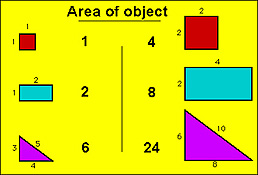 |
| | In each example, linear dimensions double, but area increases by four times. |
If you change the size of this object but keep its shape (i.e., relative linear proportions) constant, something curious happens. Let's say that you increase the length by a factor of two. Areas are proportional to length squared, but the new length is twice the old, so the new area is proportional to the square of twice the old length: i.e., the new area is not twice the old area, but four times the old area (2L x 2L).
Similarly, volumes are proportional to length cubed, so the new volume is not twice the old, but two cubed or eight times the old volume (2L x 2L x 2L). As "size" changes, volumes change faster than areas, and areas change faster than linear dimensions.
The biological significance of these geometric facts lies in the observations that related aspects of an organism's biology often depend on different geometric aspects. Take physical forces.
- The magnitude of surface tension forces is proportional to the wetted perimeter (a length); a water strider needs long feet, not big feet, to skate on the surface of a pond.
- Adhesive forces are proportional to contact areas; geckos need broad, flat feet covered with millions of tiny setae to walk on the ceiling.
- Gravitational or inertial forces are proportional to volume (assuming that density is constant); a bird that flies into a window may break its neck, but a fly that flies into a window will bounce without injury.
The same dependence on different aspects of geometry holds for functional relationships. The forces that can be produced by a muscle or the strength of a bone are in each case proportional to their cross-sectional areas; the weight of an animal is proportional to its volume.
Physiological relationships are not exempt. The rate at which oxygen can be extracted from the air is proportional to the surface area of the lungs; the rate at which food is digested and absorbed to the surface area of the gut; the rate at which heat is lost to the surface area of the body: but the rate at which oxygen or food must be supplied or the rate at which heat is produced is proportional to the mass (i.e., volume) of the animal. If an animal performs well at any given size, size change alone implies that these related functions must change at different rates, since their underlying geometric bases change at different rates; if the animal is to be functional at the changed size, either functional relations must change or shape must change. Monster movies have extensively explored these scaling relationships, albeit usually incorrectly; knowing the true relationships often puts the entire movie into a new light.
Let's start small and work our way up.
|
SESSION 2: A World Distorted Beyond Your Imagination
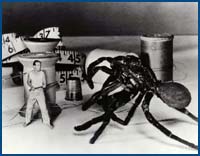 |
| Kobal Collection |  Tiny man vs. spider is a mismatch, but one that favors the man. Tiny man vs. spider is a mismatch, but one that favors the man. |
In The Incredible Shrinking Man (1957), the hero is exposed to radioactive toxic waste and finds himself growing smaller and smaller. He is lost to family and friends while fending off the household cat and must make his own way in a world grown monstrously large. He forages food from crumbs and drinks from puddles of condensation. In one famous scene, he defends himself against a house spider by using an abandoned sewing needle, which he has to struggle to lift.
Stop the projector! Time for a little analysis.
When the Incredible Shrinking Man stops shrinking, he is about an inch tall, down by a factor of about 70 in linear dimensions. Thus, the surface area of his body, through which he loses heat, has decreased by a factor of 70 x 70 or about 5,000 times, but the mass of his body, which generates the heat, has decreased by 70 x 70 x 70 or 350,000 times. He's clearly going to have a hard time maintaining his body temperature (even though his clothes are now conveniently shrinking with him) unless his metabolic rate increases drastically.
Luckily, his lung area has only decreased by 5,000-fold, so he can get the relatively larger supply of oxygen he needs, but he's going to have to supply his body with much more fuel; like a shrew, he'll probably have to eat his own weight daily just to stay alive. He'll also have to give up sleeping and eat 24 hours a day or risk starving before he wakes up in the morning (unless he can learn the trick used by hummingbirds of lowering their body temperatures while they sleep).
Because of these relatively larger surface areas, he'll be losing water at a proportionally larger rate, so he'll have to drink a lot, too. We see him drink once in the movie--he dips his hand into a puddle and sips from his cupped palm. The image is unremarkable and natural, but unfortunately wrong for his dimensions: at his size surface tension becomes a force comparable to gravity. More likely, he'd immerse his hand in the pool and withdraw it coated with a drop of water the size of his head. When he put his lips to the drop, the surface tension would force the drop down his throat whether or not he chooses to swallow.
As for the contest with the spider, the battle is indeed biased, but not the way the movie would have you believe. Certainly the spider has a wicked set of poison fangs and some advantage because it wears its skeleton on the outside, where it can function as armor. But our hero, because of his increased metabolic rate, will be bouncing around like a mouse on amphetamines. He wouldn't struggle to lift the sewing needle--he'd wield it like a rapier because his relative strength has increased about 70 fold. The forces that a muscle can produce are proportional to its cross-sectional area (length squared), while body mass is proportional to volume (length cubed). The ratio of an animal's ability to generate force to its body mass scales approximately as 1/length; smaller animals are proportionally stronger. This geometric truth explains why an ant can famously life 50 times its body weight, while we can barely get the groceries up the stairs; were we the size of ants, we could lift 50 times our body weight, too. As for the Shrinking Man, pity the poor spider.
Miniature people confront Galilean science!
Understanding scale is key to the problems raised in another classic of life on the small side. Dr. Cyclops (1940) is a tale of a mad scientist who retires to a remote island to perfect his secret machine, a device that emits atomic rays (five years before the bomb!), shrinking anything in their path. When his solitude is disturbed by interlopers (I'm convinced he mistook them for a granting agency's site-inspection team), he shrinks them; the rest of the movie follows the battles between the giant doctor and his miniaturized visitors.
 |
| Kobal Collection |  Never fear! Dr. Cyclops' tiny victim could have jumped without risk of injury. Never fear! Dr. Cyclops' tiny victim could have jumped without risk of injury. |
Much of the movie is taken up with the Lilliputian team struggling to climb up onto pieces of furniture and then back down again. For the latter, they need not have invested so much time and effort in securing pieces of string to use as ropes: they could simply have jumped. When any object falls, it accelerates until the drag force equals the force generated by gravity acting on its mass; from then on, the velocity is constant. This speed is known as the "terminal velocity"; for a full-sized human it's about 120 mph and is very terminal indeed. However, the drag on an object is proportional to its cross-sectional area, while the force due to gravity is proportional to its mass (and thus volume, if density is constant). As objects get smaller, gravitational pull decreases more rapidly than drag, so terminal velocity decreases.
Of course, as an old gem of black humor notes, it's not the fall that hurts you, it's the sudden stop at the end. A falling object acquires kinetic energy (KE=1/2mv2). That kinetic energy, proportional to the velocity squared, must be dissipated to bring the object to a halt. Here's where being small is a good thing. Not only do smaller objects fall more slowly but, because of the squared-velocity term in the kinetic energy relationship, there is much less energy to be dissipated on impact and thus less injury. (Those of you who vaguely remember Galileo dropping things from the Tower of Pisa may be bothered by the preceding. Galileo used iron balls, where the drag is trivial compared to the force due to gravity, and the fall was not long enough for the balls to achieve any significant fraction of their terminal velocity.)
Indeed, sufficiently small animals cannot be hurt in a fall from any height: A monkey is too big, a squirrel is on the edge, but a mouse is completely safe. The mouse-sized people in Dr. Cyclops could have leapt off the tabletop with a cry of "Geronimo!" secure in the knowledge that they were too small to be hurt.
Rachel Welch bombarded by molecules!
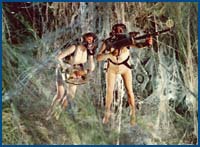 |
| Kobal Collection |  Subjected to the forces of Brownian motion, Fantastic Voyage's hemonauts were in for a very bumpy ride. Subjected to the forces of Brownian motion, Fantastic Voyage's hemonauts were in for a very bumpy ride. |
The epitome of the small-fry genre may be Fantastic Voyage (1966). A famous scientist, vital to the national defense, has an inoperable blood clot in his brain. Luckily, a secret government project has just developed a machine that can miniaturize objects. They shrink a submarine and five crew members down to microscopic size and inject them into the comatose scientist's bloodstream to find and destroy the blood clot. Lacking a copy of Gray's Anatomy, they have more adventures than they should. The scale of the hemonauts varies from viral to bacterial, depending on the scene, and a host of problems arises.
First, how do they see? The crew spend time enjoying the scenery as they cruise the arterial highways, but even at their largest size their eyeballs are much smaller than the wavelength of visible light. Even hard ultraviolet radiation is too long in wavelength to be useful. Perhaps they are using X-rays, but if so, their hapless host has more to worry about than a blood clot.
In another scene, Raquel Welch floats in a capillary, controlling the submarine remotely with a panel strapped to her waist. Remember that molecules are in constant, vigorous motion, driven by thermal energy. Trillions of molecules collide with your skin each second; all of these collisions average out to produce what we macroscopically call pressure. As objects get smaller, this random bombardment still averages out over time, but at any instant more molecules may collide with one side of the object than the other, pushing the object momentarily to one side.
This phenomenon, first described by Scottish botanist Robert Brown in 1827, is known as "Brownian motion"; the pollen grains he observed through his microscope appeared to "dance" randomly in the water. Our hemonauts in Fantastic Voyage, ten times smaller than Brown's pollen grains, are going to experience the same random and continuous jostling, rather like an endless journey on a train running on bad tracks. Raquel Welch would have been lucky to keep her hands in the vicinity of the control panel, much less actually operate the controls.
Splitting the molecule?
Other movies have played with the theme of tiny people in an otherwise normal world, including The Incredible Shrinking Woman (1981) and Honey, I Shrunk the Kids (1989). But none of these movies ever deals with the problem of what happens to the object's mass when it shrinks. I can imagine two ways to shrink an object. One would be to start removing molecules, perhaps halving the number in each cycle of shrinkage. But molecules are integer quantities; sooner or later, this strategy is going to lead to half a molecule, which won't work. (Particularly for biological objects. Remember, each cell in your body only has two copies of your genetic information, one in each strand of the DNA in your chromosomes.)
Another way to shrink an object would be to decrease the distance between an atom's nucleus and its electron cloud-atoms are, after all, mostly empty space. I'm not enough of a physicist to have any intuition about what this would do to basic physics and chemistry, but one result of this strategy would be to leave the object's mass unchanged. If volume decreases but mass does not, then density must increase. The shrinkage is sufficiently limited in these movies that we don't have to worry about dealing with miniature black holes, but an object the size of a cell but the mass of a submarine--as in Fantastic Voyage--is going to pass through the table, the floor, and the earth's mantle like a hot knife through butter.
|
SESSION 3: The Bigger They Are, The Harder They Fall
 |
| American Film Institute | | King Kong (1933) |
The other end of the size spectrum--the commonplace become gigantic--is much more the norm in monster movies and is certainly what first comes to mind when you think about the genre. The archetype is, of course, King Kong. There have been a host of Kong movies, but the best are clearly the original (1933) with Fay Wray, the 1976 remake with Jeff Bridges and Jessica Lange, and a 1949 clone entitled Mighty Joe Young (whose special effects, by Ray Harryhausen, are breathtaking). Yet all underestimate the vulnerability of large animals.
As J.B.S. Haldane put it in his classic essay, "On Being the Right Size," "You can drop a mouse down a thousand-yard mine shaft; and, on arriving on the bottom, it gets a slight shock and walks away....A rat is killed, a man broken, a horse splashes." Haldane was being quite literal.
These facts were known to our ancestors, who used this aspect of scaling to gruesome effect--a common strategy during medieval sieges was to take a carcass of a horse, let it ripen for a few days in the sun, and then catapult it over the walls of the besieged town. On impact, the carcass would indeed splash, spreading contagion throughout the city.
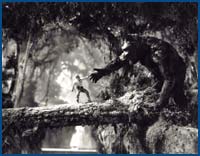 |
| Kobal Collection |  King Kong's imposing size--about 22 feet tall in this scene--makes him vulnerable to injury. King Kong's imposing size--about 22 feet tall in this scene--makes him vulnerable to injury. |
The really large terrestrial animals are all extinct, but we still have elephants and rhinos for a bit of insight into this problem. Think of the last time you went to the zoo. True, there was a fence around the elephant compound, but a moment's reflection will convince you that the fence can't be meant to keep the elephants in--all they would have to do is lean against the fence to bring it down. No, the fence is there to keep you out. What really keeps the elephants in is the dry moat around their compound; a fall of half a dozen feet would shatter the bones in the elephants' legs and the elephants know that very well indeed. One of the major flaws of all the Kong movies is that the giant apes are just too active, leaping and crashing around as if they were monkeys, protected by their small size. Remember the elephants, and look on these antics with a bit more skepticism.
A second, more subtle, problem pervades the Kong movies. The strength of a bone is approximately proportional to its cross-sectional area; this is simply another way of saying that there is a maximum mechanical stress, or force per unit area, that a bone (or any other material object, for that matter) can withstand. The load the bone must bear is proportional to the mass of an animal. With an increase in size but no change in shape, the load on the bone will increase in proportion to the increase in volume (length cubed), but the cross-sectional area of the bone will only increase as length squared. Eventually, the animal's bones will break under its own weight.
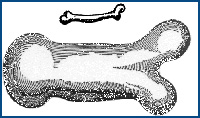 |
|  Galileo sketched the change in shape necessary for a bone to support a larger animal. Galileo sketched the change in shape necessary for a bone to support a larger animal. |
One way around this problem is to change the shape of the bone as size increases, so that the cross-sectional area better follows the increase in the animal's mass. This is a widespread trend in biology--larger animals have proportionally stouter, thicker bones. Compare the skeletons of a cat to a lion or that of a deer to a moose. This observation is not exactly hot news--both the trend and its explanation were given by Galileo in Two New Sciences (1638).
But my colleague Andrew Biewener (formerly at the University of Chicago, now at Harvard's Concord Field Station) has revisited this question with surprising results. At least for the long bones in the limbs of mammals, the changes in shape that accompany evolutionary changes in size are not sufficient to compensate for the increased loads. Since all bone has virtually the same breaking stress, this implies that larger animals increasingly push the limits of their own skeletons' strength. However, Biewener's direct measurements of bone deformations as an animal walks or runs show that the safety factor (the ratio of breaking stress to working stress) only ranges from three to five. This is remarkably risky design--most things that humans build have safety factors from ten to several hundred. Biewener has looked at animals from chipmunks to elephants and finds that the safety factor is constant across this 25,000-fold size range--scaling has been sidestepped. This result is achieved by a combination of the shape changes in the bones described by Galileo and changes in the behaviors of the animals, particularly adjustments in posture to ensure that the loads the bone must bear are directed along the bones to minimize bending.
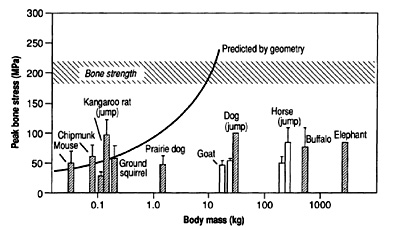 |
| Andrew Biewener | | Chart of peak bone stress |
The chart at right describes Biewener's findings. On the horizontal axis is body mass, running from a tenth of a kilogram (about three ounces) on the left to 5,000 kilograms (about 5 tons) on the right. The vertical scale is stress, measured in force per unit area. The strength of bone does not vary from one mammal to another: for all mammals, bone breaks when the stress it carries exceeds about 200 megapascals (Mpa)--the hatched region in the middle of the graph. Say you had an animal the size of a chipmunk (body mass about 0.1 kg). Its bones have been measured to carry a stress of about 50 Mpa during routine locomotion. What if that chipmunk got bigger, either through evolution or the effects of consuming radioactive tomatoes, as in so many of these movies? If the chipmunk's bones simply enlarged proportionally with no change in shape, stress in the bone would follow the solid curve on the left, with stress increasing as the cube root of body mass. Note that at about 10-20 kg body mass (about 20-40 pounds), that line intersects the hatched region. The implication is that at that size, our hypertrophied rodent cannot move--even routine locomotion would generate high enough stresses to break its bones.
But clearly there are mammals larger than 10-20 kilograms--you and I, to name two. Indeed, empirical measurements of the working stresses in bones indicate a very different story. The bars on the graph indicate the working stress levels in the bones of a variety of mammals from mice to elephants; hatched bars are indirect estimates from the measures of the forces the animal exerts on the ground, white bars are direct measurements from strain gauges directly attached to the animals' long bones. As is apparent, bone stress does not grow as the cube root of body mass. Indeed, the working stress in the bones seems to be independent of body size, running about a fourth to a third the breaking stress for all mammals. In a sense, what we have here is nature's "design principle" for mainstream skeletons: all have evolved to have a safety factor of three to five.
 |
|  Upright posture allows animals to support greater weight. Upright posture allows animals to support greater weight. |
As mentioned above, this is achieved by changes in posture. Small mammals run with their limbs bent; large mammals always run with their limbs straight. If you've ever seen a slow-motion movie of a horse running, you may have noticed that the horse's leg is perfectly straight when it contacts the ground and it stays straight as long as it's bearing the horse's weight. This behavior is even more obvious in elephants.
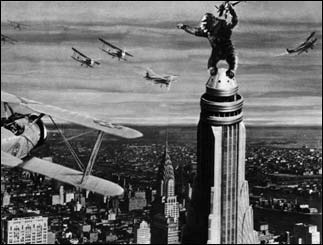 |
| American Film Institute | | Good posture has its limits. Even standing straight, King Kong could not support his incredibe bulk. |
Back to King Kong. Based on some measurements from stills from the original movie, at the beginning of the movie Kong is about 22 feet tall, but by the time he climbs the Empire State Building, he appears to be 50 percent bigger, presumably because he was allowed bananas ad libitum. At 22 feet tall, Kong is about four to five times the size of your garden-variety lowland gorilla. A fivefold increase in height implies a 25-fold increase in bone cross-sectional area and a 125-fold increase in body mass; the stress on the bones thus should be about five times greater than the stress on a normal gorilla's bones. But, remember, according to Andy Biewener's data, a safety factor of five is extreme for mammals; Kong's excessive body size should have exhausted the safety factor. True, Kong stands a bit straighter than the average gorilla so he may gain a bit of the safety factor back, but it's clear that he's pushing the envelope. Is that why he has such a short fuse and is always roaring and bashing things? Not only does he continually run the risk of breaking his legs, but undoubtedly his feet hurt.
 |
| American Film Institute | | The relatively slender 50-foot Woman violated traffic laws and the rules of safety factor. |
Kong may be pushing the limits of his bone strength, but other movies have clearly crossed the line. In The Amazing Colossal Man (1957), a 100-foot (but normally proportioned) man menaces Las Vegas. Although, based on his size, we would assume his first step should be his last, somehow he manages to survive a fall off Boulder Dam and return for the sequel, War of the Colossal Beast (1958). The protagonist in Attack of the Fifty Foot Woman (1958) is only half the size of the Amazing Colossal Man, but she also pushes the skeletal safety factor beyond reasonable limits.
|
SESSION 4: Terrors of the Deep
I am, by training, an invertebrate zoologist, and virtually all of my research has focused on the biomechanics of marine invertebrates. Thus I note with considerable joy that Hollywood has not forgotten our slimy relatives. My all-time favorite for quality of special effects is It Came from Beneath the Sea (1955), in which a giant deep-sea octopus, unable to capture its normal prey after it becomes radioactive from eating fish contaminated in an atomic bomb test, invades shallow waters looking for lunch. After snacking on a couple of freighters, the monster discovers San Francisco, where he adds a few police cars, railroad box cars, and the clock tower of the Ferry Building to his diet. The most famous (and visually striking) scene occurs as the monster reaches up out of San Francisco Bay, entwines its tentacles around the Golden Gate Bridge, and pulls the bridge down.
This moment is the creature's undoing, although the movie seems not to realize this fact. After this point, the creature becomes strangely passive, especially in light of its previous rampages. The octopus grabs an attacking submarine, but simply holds it, making no attempt to crush it or bite it. The octopus ignores a scuba diver who swims directly in front of its eye, even when the diver shoots a spear into its brain (which can't have done much damage even if it did actually penetrate the cartilaginous brain case). Finally, the monster is dispatched with explosives and the movie ends. Pulpo, anyone?
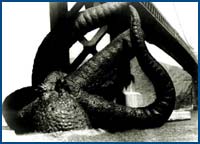 |
| Kobal Collection |  In the movie, the giant octopus pulls down the Golden Gate Bridge. But raising its limbs so far out of the water may have been the creature's undoing. In the movie, the giant octopus pulls down the Golden Gate Bridge. But raising its limbs so far out of the water may have been the creature's undoing. |
So what happened at the Golden Gate Bridge to completely change the creature's behavior? I think the answer is pretty simple. Any time you have a column of water extending vertically, a pressure is generated at the bottom of the column; one atmosphere of pressure is produced for each 33 feet of height. Our giant octopus, like all macroscopic animals, has a circulatory system extending throughout its body--in essence, pipes (here, large pipes) filled with water. If the octopus extended its tentacles vertically while it was submerged, nothing would happen; the pressure would increase at the base of his tentacles, but that pressure would precisely match the pressure in the surrounding water (which can also be viewed as a column of water).
However, before pulling the bridge down, the monster extends his tentacles about halfway up the support towers. The top of the support towers stand 500 feet above the deck, itself 220 feet above the high-water mark. At one atmosphere for every 33 feet and an elevation of 470 feet, that's a total pressure of about 14 atmospheres (209 pounds per square inch). For the first time in its life, there was no surrounding mass of water to offset the pressure increase and the full load of this pressure would act to distend its arteries.
The evidence clearly points to the poor cephalopod suffering a sudden and massive cerebral hemorrhage from this excess pressure just as it rips down the Golden Gate Bridge. The subsequent passivity of the giant octopus now makes perfect sense--its higher faculties were gone and the only responses it made were due to peripheral reflexes, grabbing the submarine in response to tactile stimulation, twitching when hit with the diver's spear. Rather takes the edge off the human's "heroic" actions at the end of the movie, doesn't it?
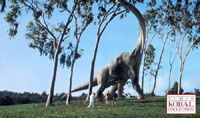 |
| Kobal Collection | | Could sauropods have feasted on treetops? Some scientists have questioned whether their hearts could pump blood to such heights. |
Similar but less severe problems afflict giraffes, who have to have taut skin on their legs (a living version of Supp-hose) to minimize edema (fluid being forced from the capillaries into the tissues due to the high pressure). Things must have been even worse for the large sauropod like Apatasaurus and Brachiosaurus. Indeed, some folks have suggested that they couldn't have lifted their heads straight up without passing out; it is doubtful their hearts were strong enough to pump blood that high. The poor dinosaurs couldn't have avoided the problem as the octopus did for most of the movie--by keeping the body submerged. A sauropod standing submerged with only its head sticking out of the water would have no problem with edema in the legs or low blood pressure in the head, but if the lungs were deeper than 8-10 feet down, it is doubtful that it would have been able to breathe; it is unlikely that it would have been able to inflate its lungs against the ambient pressure.
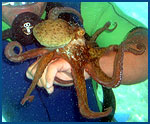 |
| Krisztian Pinter |  The Octopus is a member of the phylum mollusca. Click here for more on animal diversity. The Octopus is a member of the phylum mollusca. Click here for more on animal diversity. |
There haven't been a lot of other molluscs that have starred in monster movies; it's enough to make an invertebrate zoologist cry, especially since molluscs are the second most diverse phylum on the planet. (Arthropods are first; chordates, the group to which the vertebrates belong, come in a distant third.) Most of Hollywood's efforts along these lines have focused on arthropods. Here, at least, there's a descent representation of biodiversity with giant crustaceans (Attack of the Crab Monsters, 1957), chelicerates (Tarantula, 1955; The Black Scorpion, 1957; Earth vs. the Spider, 1958), and an array of insects ranging from flies to giant preying mantises.
Let's turn to one of my favorite giant insect flicks.
Tokyo falls to giant saturnid!
For high camp, you can't do better than Mothra (1962). Two six-inch tall women are kidnapped from a Pacific island by a showman who plans to make his fortune by exhibiting them. The dastardly deed causes a giant egg to hatch into a giant caterpillar that swims across the Pacific, devouring everything in its path, and getting bigger by the minute. After reaching Japan and crushing a large portion of Tokyo, it crawls up a radio tower, spins a cocoon, and a few days later emerges as a moth with the wingspan of a couple of 747s. The downdraft of those wings completes the destruction of Tokyo: buildings are blown down, cars fly through the air. The authorities admit defeat and the tiny women are brought to the airport where the giant moth lands; after the ladies climb aboard, the monster flies off over the Pacific, never to be seen again.
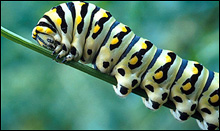 |
| arttoday.com | | Caterpillars rely on a flexible hydrostatic skeleton for support and locomotion. |
Caterpillars are peculiar beasts. Unlike adult insects, which have a rigid external skeleton, caterpillars have a flexible skin and support themselves with what is known as a hydrostatic skeleton--a volume of incompressible fluid that transmits forces and pressures from muscular contraction through the body. In essence, they are animated water balloons with the incompressible fluid (the blood, filling all of the body cavities) surrounded by a tension-resisting skin. Like the giant octopus in It Came from Beneath the Sea, the caterpillar ought to generate some extreme pressures when it crawls up the radio tower. What's more, the tensile stress in a pressurized cylinder (a reasonable model for a giant caterpillar) is directly proportional to the radius of the cylinder; since the caterpillar has a radius of about 30 feet, the stresses are going to be extreme. Mothra's skin must be reinforced with something having a tensile strength well in excess of steel.
Enlarging an insect to this size raises other interesting problems that don't arise with large vertebrates. Take the respiratory system. Insects have a remarkably efficient respiratory system with a basic design completely different from what we possess. Rather than inhale air, extract oxygen in the lungs, and transport it in the blood as we do, insects have a branched, tree-like network of tubes called trachea that extend through the body and open at one end to the atmosphere. Large insects may actively ventilate the outer portions of this network, but the inner regions (the smaller tubes) are not ventilated; instead, oxygen simply diffuses down the tubes.
It's a remarkably efficient system: The transport of respiratory gases is free, increased demand for oxygen at any location automatically increases the local rate of supply by increasing the concentration gradient of oxygen, and the system can be easily modified to better deliver oxygen to particular regions of the body. (For example, in the flight muscles of insects where the oxygen demand is extreme, the tips of individual tracheal tubes actually penetrate the cell membrane, directly delivering oxygen to the mitochondria in the muscle cell's cytoplasm.)
 |
| Kobal Collection |  Mothra might be able to get off the ground, but fighting the wind and landing present stiff challenges. Mothra might be able to get off the ground, but fighting the wind and landing present stiff challenges. |
However, because the system is diffusion-based, it does have limitations. Rate of delivery of oxygen is directly proportional to the concentration gradient along the tube, inversely proportional to the length of the tube, and directly proportional to the cross-sectional area of the tubes. Ah, but demand for oxygen is going to be more or less proportional to the biomass of the animal--i.e., the volume. As an insect increases in size, demand for oxygen will increase in proportion to length cubed, but rate of supply will only increase as length squared. You could always decrease demand by having the insect live a more leisurely life, but that's not an option if Mothra is ever going to get off the ground--flying is a very power-intensive behavior, for machines or animals.
The upshot of all this is that Mothra is going to have to add a lot of tracheal tubes to maintain a sufficient oxygen supply. Of course, the more of its volume that is tracheal tubes, the less is biomass that needs oxygen, but this implies that although Mothra may be heavy (because it's big), its density is going to be very low--about the same as your average cotton ball.
This insight into Mothra's physiology eliminates two other problems. Although wearing one's skeleton on the outside has distinct mechanical advantages (as we'll see shortly), large insects are prone to a mode of failure called buckling. If Mothra had really been just a scaled-up moth, its legs would have collapsed when it landed. Second, Mothra's wings are in the same proportion to its body as the moths that bat their heads against the lights outside your door. Total lift generation is proportional to the area of the wings; if mass increased in proportion to volume, Mothra would have to walk home. If Mothra could get airborne, it would produce a sizable downdraft, although probably not anywhere near enough to blow over buildings, but its low density implies that it is going to be at the mercy of the winds. I sure hope those six-inch ladies got home.
|
SESSION 5: Giant Ants Attack!
Another giant bug movie is worthy of note. Them! (1954) opens in New Mexico with a house trailer that has been ripped open by some unknown agent; the only survivor among the occupants is a six-year-old girl so traumatized that she can give no clue as to what transpired. Soon we discover that the trailer was attacked by ants, but they're not the ants that usually visit you at a picnic. These ants stand 12 feet high, swollen to giant size by the effects of the radiation from the Trinity atomic bomb tests in 1945.
These super-ants have several problems, although neither they nor the humans seem to appreciate it. First, let's start with the vulnerability of an insect the size of a small elephant. The giant insects don't look terribly vulnerable--small arms and machine guns don't seem to have much effect on them. Part of this relative invulnerability is certainly
due to the fact that arthropods wear their skeleton on the outside, where it can act as armor, but I'd argue that the military is using the wrong weapons and aiming at the wrong targets.
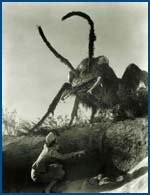 |
| Kobal Collection |  Aim low! The head and body of a giant ant make poor targets, but the legs are vulnerable to buckling. Aim low! The head and body of a giant ant make poor targets, but the legs are vulnerable to buckling. |
Insects have a much more distributed nervous system than vertebrates, so the head is a pretty poor target. So is the body. Because of their highly efficient respiratory system (see Mothra, in Session 4), circulatory demands are much lower in insects than in vertebrates; they can get away with a fairly low-pressure circulatory system. A hole in the exoskeleton, even a 30-caliber hole, just isn't going to bleed much, and the hole will be quickly sealed because insect blood has excellent clotting characteristics. The heart is on the dorsal side of the body, so it, too, makes a lousy target.
So where are they vulnerable? The secret lies in the exoskeleton. Hollow tubes are mechanically very efficient structures, especially for resisting bending--the nastiest way you can load a structure. (Don't believe me? Take a toothpick and break it. Easy, wasn't it? But you broke it by bending it, so take another toothpick, grab one end in each hand, and pull straight along the length of the toothpick. Pretty tough in pure tension, isn't it? Now take another toothpick and grab it between the thumb and first fingers of each hand, with your thumbs a half inch or less apart, and try to break the toothpick by pushing along the length of the toothpick. Pretty tough in compression, too.)
Resistance to bending is maximized if the material is distributed far away from the middle of the beam, so tubes are very efficient, but thin-walled tubes have a peculiar vulnerability. Take a soda straw and push on the ends. At first the soda straw will bend smoothly, but at some point it will suddenly fly out of your hands; if you retrieve the straw, you'll find it has a kink in it and, if you load it again, it has lost much of its previous resistance to loading. This mode of failure (known as "local buckling") is peculiar to thin-walled structures. Now, if our giant ants are scaled-up versions of their normal relatives, the length, diameter, and thickness of the exoskeleton in their legs will all be scaled up by the same linear factor, but their body weight, again, will be scaled up by that linear factor cubed. These giant insects are clearly pushing the buckling strength of their legs.
Notice that local buckling is always an inwards kink in the tube, so any focused insult from the outside is going to tend to trigger local buckling. Here's the trick to defeating the giant ants. You don't want a rifle, you want a pile of bricks and a good pitching arm. One well-hurled brick hitting a leg and--plink!--the leg goes into local buckling and collapses, increasing the load on the remaining legs. Two more bricks and you've taken out all the legs on one side; all the bug can do is scrabble in circles. Three more bricks and the giant insect is completely immobilized.
There's another mechanical problem that these giant bugs must face, and this one is even more interesting because it has both biological and financial implications. All animals with rigid skeletons face the problem of the transmission of forces between the elements of their skeleton. Because these boundaries between elements are usually the place where movement of skeletal elements occurs (i.e., joints), this boundary must withstand the forces carried by the rigid skeletal elements and do so while maintaining a low friction. In less formal terms, a joint must not fail under the applied loads, and must transmit those loads while remaining free to rotate.
Here vertebrates have a real advantage over arthropods. Because our skeleton is internal, the ends of the bones can articulate on enlarged, rounded surfaces--think of the articulation between your hip and your femur. The large surface area helps keep the mechanical stresses low, and the joint can be lubricated because it is surrounded by living tissue. In arthropods, because the skeleton is external to the living tissue, large rounded ends are out of the question. The best an arthropod could do would be to have one tube of its exoskeleton butt up against another tube--imagine two tea cups, edge to edge--and even that wouldn't work because any rotation around the joint would end up with the two tubes contacting each other at a point, which would both yield very high stresses and would be mechanically unstable.
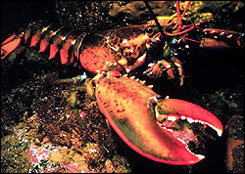 |
| National Oceanic and Atmospheric Administration | | In arthropods, pin joints--like those between a lobster's "thumb" and "hand"--connect segments of the exoskeleton. |
Instead, arthropods join one element of their exoskeleton to another (at least in their limbs) by what are formally called "pin joints"--a pair of small protuberances 180° apart on the end of one skeletal element fit into a matching pair of depressions on another element. Pin joints have very small areas compared to the skeletal elements themselves, so the stresses they must carry are very high. To maximize the strength and hardness of these pin joints, arthropods modify the material in their exoskeleton, heavily cross- linking the chitin and protein. If you're still having trouble visualizing these pin joints, go out to dinner and order lobster; you'll find a pin joint between the "thumb" and the "hand" in the claw, and between all of the segments of the legs.
One estimate suggests that mammalian joints are called on to withstand forces as much as 100 times the animal's body weight during normal locomotion. (In humans, the peak forces on the knee during running can be 15 times body weight.) Arthropods, even though they have more legs than mammals, have it even worse; their joints may see forces as great as 3,000 times body weight, 30 times higher than mammals. Because joint contact areas are much lower in arthropods than vertebrates, the difference in stresses must be much greater. Now we come to the heart of the matter. As you scale up an ant, body mass must increase faster than joint surface area--indeed, the stress on the joint should increase in direct proportion to size.
These giant bugs have a problem, and I can think of only one way out for them. The joints must be made of some very hard material (to minimize wear) with good mechanical properties, and only one material will fit the bill--diamond. You scoff? Diamond is only carbon, and living things have a lot of experience in manipulating carbon. So why didn't the characters in Them! notice that the giant insects had diamond-lined joints? In Them!, you'll remember, the giant ants are finally defeated by burning out their nest with flamethrowers. As I said, diamond is just a form of carbon, and like the more prosaic forms will burn quite nicely. The evidence literally went up in smoke.
|
SESSION 6: The Fantastic World of Mr. Spielberg
Sometimes, there is evidence of real sophistication in monster/science-fiction movies; for the very best, I recommend the Stephen Spielberg classics Jurassic Park (1994) and ET (1982). Although very different in tone and subject matter, the two share remarkable insights into biology.
When Jurassic Park was first released, I went to see the film with a paleontologist colleague and our respective wives. As the rest of the audience cringed and shrieked, my colleague and I excitedly whispered comments to each other--"All right! Classic large predator behavior patterns!", "Look at that! They got the bipedal kinematics just right!" Folks in adjacent seats were not amused. The Tyrannosaurus and Gallimimus sequences are truly breathtaking. If you want to see our best guess as to how dinosaurs moved and behaved, see this film; Spielberg had a number of vertebrate paleontologists and biologists as consultants, and he obviously listened to them.
I have only two quibbles with this film and they are both minor ones. First, the title--although I suppose that Spielberg was stuck with the title Michael Crichton used for the novel. Except for the Brachiosaurus (and the Dilophosaurus, which was a complete fiction), all of the dinosaurs in Jurassic Park actually lived in the Cretaceous--but what's 100 million years among friends?
My second quibble has a bit more substance, for it concerns the posture of the Tyrannosaurus. For most of this century, Tyrannosaurus has been reconstructed as standing with its body vertical, crouched on its hind limbs--the Tyrannosaurus in Disney's Fantasia (1940) is a good example of this "classical" view, one probably unconsciously modeled after our own bipedal posture. More careful consideration of the biomechanics of large carnosaurs--the position of the center of gravity, the widespread presence of calcified tendons in the backbone, the massive tail--led in the 1980s to a radically new vision of the carriage in these animals, one where the body and tail were held horizontally and more or less rigidly balanced over the hind legs. At first sight this reconstruction is jarring--rather like an ambulatory seesaw--but a bit of reflection will convince you that this posture is more, not less stable than our own precarious position perched above our hind limbs, although almost certainly less maneuverable in turns (as David Carrier has shown). This is the view portrayed in Jurassic Park, and the efficacy of this posture is apparent and seems quite natural when the T. rex in the film is seen in motion.
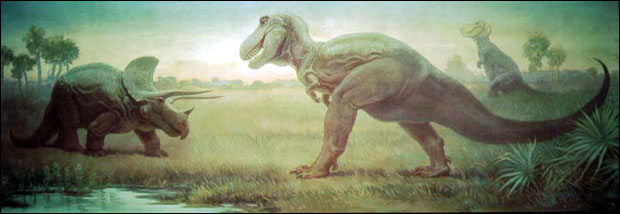 |
| The Field Museum, #CK9T | | A painting by Charles Knight in Chicago's Field Museum of Natural History shows a confrontation between a Tyrannosaurus and Triceratops--a popular subject in movies and illustrations of the days when dinosaurs walked the earth. The "classical" view of the T. rex posture seen here--body verticle, hind limbs bent--has since been rejected by researchers, who now believe that T. rex kept its body parallel to the ground and its hind limbs straight. |
As I mentioned in Session 3, Andrew Biewener has made a career of studying the biomechanics of locomotion in vertebrates, particularly the effects of changing body size on locomotory design and behavior. One of his primary conclusions is that to avoid fracturing their own bones, very large animals must maintain their legs straight, with all of the long bones in a single line when the limb bears the animal's weight. Here's where Jurassic Park goofed, although it's a pretty minor error. Watch the climactic final scene in the lobby of the lodge, where the Tyrannosaurus and the Velociraptors settle their differences. You'll see that the Tyrannosaurus keeps his knees bent, and the upper portion of the leg (the thigh or drumstick, depending on which analogy you like better) is always at least 30° off the line defined by the lower portion of the leg--more like the posture of a large bird than a mammal. It now seems much more likely that an animal the size of this beauty must have kept both the upper and lower portions of the limb in line when that leg was weight- bearing; this would have given Jurassic Park's T. rex another foot or two of elevation, and, if you can visualize the stride in your imagination, made it even more intimidating.
Alien Manipulates Human Emotions!
Another Steven Spielberg blockbuster, ET (1982), exhibits an entirely different kind of sophistication. (Okay. So maybe ET isn't a "monster" movie, but bear with me--the point is interesting.) The first time the audience gets a good look at ET, there's an audible sigh of "How cute!" that sweeps through the movie theater. You do indeed think ET is cute, but why do you think he's cute?
 |
| arttoday.com | | A puppy and an adult dog illustrate one of Stephen Jay Gould's points about shape changes in mammals: the length of the snout relative to the rest of the head increases over time. |
A few years ago, the late Stephen J. Gould wrote an article for Natural History on the evolution of Mickey Mouse. Gould pointed out that, as time progressed, Mickey Mouse got younger, not older. All mammals go through a regular series of shape changes as they grow and mature. The limbs grow longer with respect to the body, the body grows larger with respect to the head, the head grows larger with respect to the eyes, but the lower part of the face (the "snout") grows larger with respect to the rest of the face and head. These are regular and stereotyped changes in proportion during the development of all mammals.
 |
| arttoday.com | | Why do we find squirrels and kittens so cute? Big eyes, short snouts, disproportionately large heads--traits they share with infants and children. |
Juvenile mammals, then, are immediately recognizable as such; they have large eyes relative to their heads, small snouts, and disproportionately large heads and short limbs. These characteristics are particularly apparent in the young of our own species, and we're hard-wired with a propensity to react to such characteristics with nurturing behaviors. This is why you find puppies and kittens "cute"--their bodies have the proportions that shout "infant" to your hindbrain. And this is why you find squirrels (which are basically tree rats) cute--even as adults, they have disproportionately large eyes and short snouts.
During Mickey Mouse's maturation from his first appearance as Steamboat Willy to his glory days with the Mickey Mouse Club, his head and eyes became larger and his snout proportionally smaller; he juvenilized, presumably increasing his marketability.
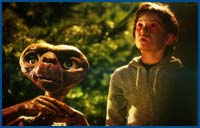 |
| Kobal Collection |  It's no accident that people thought ET was cute. His physiognomy is intended to mimic the features of kittens, squirrels, and children. It's no accident that people thought ET was cute. His physiognomy is intended to mimic the features of kittens, squirrels, and children. |
This is ET's secret for tugging your heartstrings. ET has a very flat face and large eyes, his head is large relative to his body, and his limbs are ridiculously small--his body proportions are exaggerated versions of the children's. Like kittens and squirrels, ET appeals to your hindbrain for nurturing and protection, and it's a rare person who can resist the appeal.
The trick to ET's charm may seem trivial and obvious, but it really is neither. As a counterpoint to ET, consider King Kong Lives (1986), a sequel to the 1976 version of King Kong. The premise of the movie is that Kong survives his fall from the World Trade Center (patently impossible, as we saw in Session 3) and is fitted with an artificial heart the size of a Volkswagen, restoring him to his full imposing health. Kong eventually meets a female version of himself captured in the Indo-Pacific, they fall in love, one thing leads to another, and soon Mrs. Kong is expecting.
The scene where Kong Jr. is born was fascinating, but not for anything that happened on the screen. Clearly the directors expected Kong Jr. to be an object of sympathy to the audience, but when Junior appeared I clearly remember that the audience around me looked puzzled, not charmed. The explanation is simple. On screen, the relative sizes of Daddy, Mommy, and Baby Kong were more or less correct, but Junior was a man in a gorilla suit and the audience's hindbrain knew by the body proportions that this was no newborn, regardless of what the story line or the relative sizes said. We are not fooled that easily.
|
ABOUT THE AUTHORMichael C. LaBarbera
Michael C. LaBarbera is a professor in Organismal Biology & Anatomy, Geophysical Sciences, the Committee on Evolutionary Biology, and the College of the University of Chicago.
COPYRIGHT
Copyright 2003 The University of Chicago.